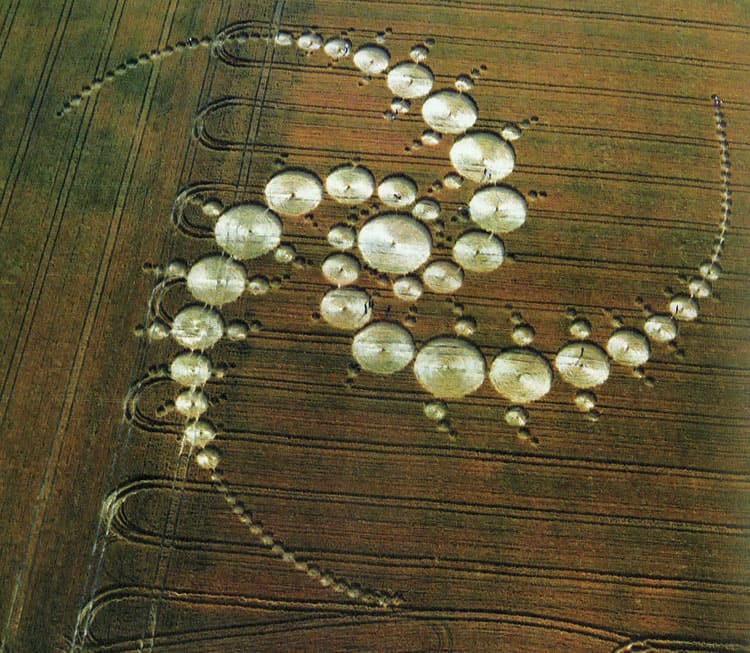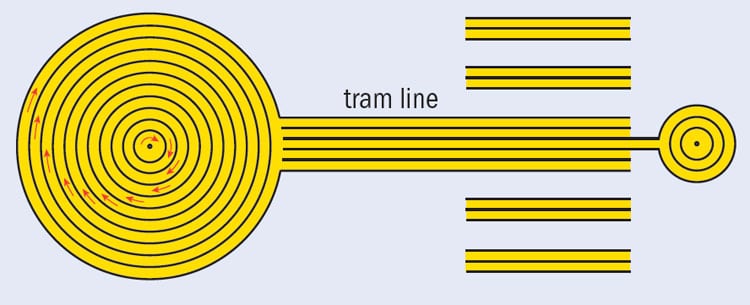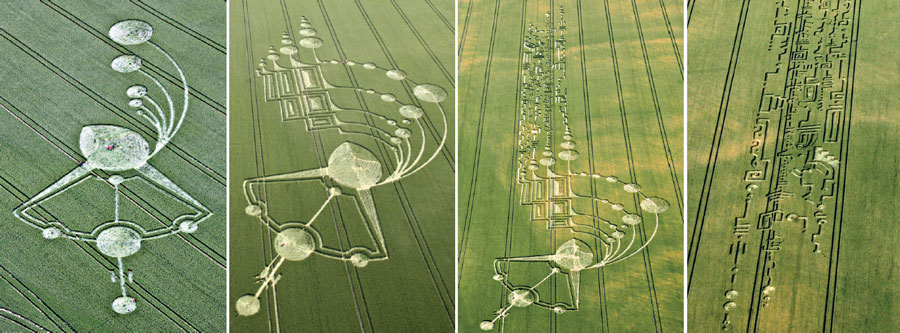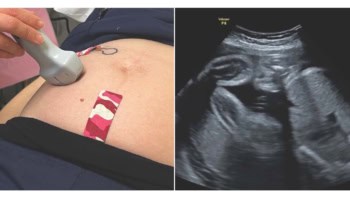Serious studies of crop circles have long been hampered by conspiracy theories and the secretive nature of circle-makers – plus scientists' reluctance to engage with a "fringe" topic. But, as Richard Taylor argues, discovering how circle artists create their most complex patterns could have implications for biophysics
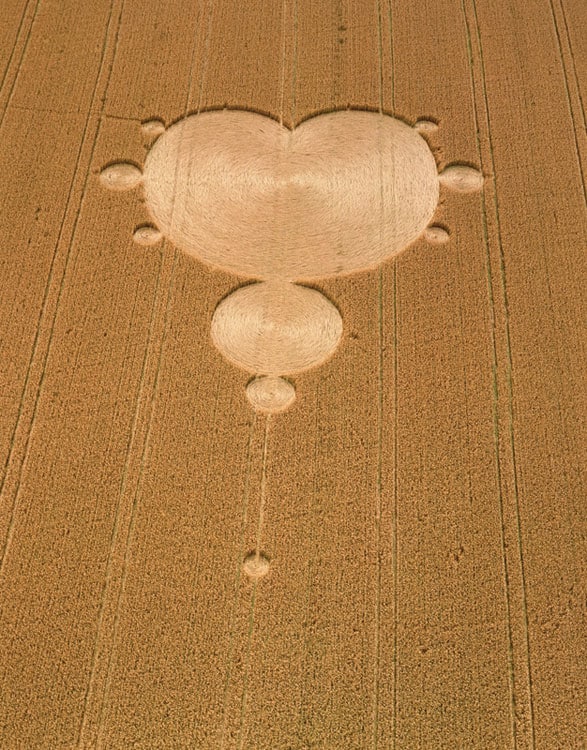
One evening in July 1996 I was staying above a country pub near Avebury in Wiltshire, enjoying a week’s holiday drive around the prehistoric sites of southern England. In the middle of the night, I awoke to the hushed sounds of three men talking in the car park below. They were huddled around a large sheet of paper, and after 15 minutes of furtive discussion, they sped off down a country lane. That same evening, 194 “crop circles” spanning a total of 115 m appeared in a nearby field at Windmill Hill. Their pattern, which was derived from an equation developed by Gaston Julia in 1918, consisted of circles that defined three intertwined fractals (figure 1). This “Triple Julia” pattern is mathematically complex: as late as the 1980s, even the best computers lacked the processing power needed to generate it on screen. Had those three men managed to physically imprint the same pattern into a wheat field during the short hours of that midsummer night? And if so, how did they do it?
Some 15 years on, scientists still do not know the answer. With more than 10,000 patterns documented over the years, crop formations remain a major scientific mystery, one that plays out in our fields – and thus in our food supply – at the rate of one event worldwide every summer evening. Physicists who have conducted serious research on the techniques of crop-circle artists have come away with fascinating insights, including some that have led to practical advances, such as a patented technique for accelerating crop growth. With recent announcements that climate change has suppressed crop growth by 3%, such advances offer clear potential rewards for society. Yet crop-circle research is not for the faint of heart, because physicists who enter it must deal with media manipulation, hate-mail, conspiracy theories, supposed alien collaborations and new-age nonsense – not to mention the risk of being viewed as “less than serious” by their colleagues.
Devils, aliens, whirlwinds and hoaxers
Speculation over the origin of crop circles has raged since they were first reported in England in the 1600s, with rolling hedgehogs, urinating cattle, romping romantic couples and the actions of a “mowing devil” all offered as early explanations. In 1678 a series of circles in Hertfordshire was attributed to the devil because the manufacture appeared to be beyond human capabilities. According to a report in a 1678 issue of News Out of Hartfordshire, the devil “placed every straw with an exactness that would have taken up above an age for any man to perform what he [the devil] did that one night”. More prosaically, the woodcut print that accompanies the report also indicates that the stalks within the circle were flattened rather than broken – a practice that continues today.
The first scientific explanations of crop circles focused on cyclonic winds. In 1686 the British scientist Robert Plot discussed crop-circle formation in terms of airflows from the sky. Similarly, observations of the night sky by another scientist, John Capron, in 1880 revealed a wind-induced “auroral beam” above the “circular spots” of flattened crop (Nature 22 290). However, as the phenomenon gathered momentum, and more elaborate, multi-circle shapes appeared in crop fields, most observers concluded that these symbols of mathematical precision had to be the work of intelligent beings. In the waning decades of the 20th century, this conclusion ignited a heated aliens-versus-humans debate, with “UFOlogists” looking to outer space for the circles’ artistic creators, while “cereologists” concentrated on hunting for terrestrial hoaxers. This debate was complicated by the fact that the creators (whoever they were) were clearly science-savvy. In particular, one formation that appeared next to Chilbolton Observatory in Hampshire appeared to be a reply to a “search for extraterrestrial intelligence” signal beamed into space 30 years earlier.
As the debate raged, some scientists continued to seek alternative natural explanations. One of the most prominent was Terence Meaden, then a meteorologist and physicist at Dalhousie University in Canada. In 1980 Meaden refined Capron’s theory, proposing that the curvature of hillsides in southern England affected the local airflow, allowing whirlwinds to stabilize their positions long enough to define circles in the crop fields.
Such scientific speculations received a severe blow in 1991 when, to the glee of the British media, two unassuming men in their sixties declared that they had been creating crop circles for more than 25 years. Their hobby had begun one summer evening in the mid- 1970s, when artist Douglas Bower recounted a story to his friend David Chorley about an Australian farmer who had reported a UFO rising into the sky and leaving behind a circular “saucer nest”. As Bower and Chorley strolled home from the pub through the English countryside, they created their first imitation nest.
In the process, the pair unintentionally triggered a 15-year duel between art and physics. Bower and Chorley were trying to start a UFO hoax, so when Meaden’s meteorological theories of crop-circle formation showed signs of catching on, the pair increased the number of circles in their formations, hoping to demonstrate that they were not weather-related. Meaden, however, proved an inventive (albeit unwitting) opponent. By the time Bower and Chorley went public, Meaden had moved on from mere weather patterns to an electromagneto-hydrodynamic “plasma vortex”, which purported to explain not only the elaborate multi-circle designs, but also the flat farm tractor batteries and eerie lights that coincided with their formation!
Today, with the benefit of hindsight, such explanations sound rather contrived. At the height of the debate, though, no less a physicist than Stephen Hawking was prepared to accept some version of Meaden’s theory. When a spate of circles appeared in the countryside near his Cambridge home in 1991, Hawking told a local newspaper that “crop circles are either hoaxes or formed by vortex movement of air”.
Frustrated, the artists countered by producing a pattern that included two circles and five rectangles (figure 2). At this point, even Meaden conceded that these straight-line designs, labelled “pictographs” by researchers, were man-made, although he stressed that simple circles could still be a consequence of atmospheric phenomena. After all, even after Bower and Chorley confessed to making 250 formations, that still left more than 1000 other formations unaccounted for. But the addition of straight lines did more than just rule out natural causes for their designs. It also signalled a turning point in the 400-year history of crop formations.
Creating mathematical patterns
After Bower and Chorley announced their hoax, the pictographs they created inspired a second wave of crop artists. Far from fizzling out, crop circles have evolved into an international phenomenon, with hundreds of sophisticated pictographs now appearing annually around the globe. Although up to half of each year’s crop circles are in England, formations also occur elsewhere in Europe, as well as in North and South America, Russia, Australia, Japan and India.
Artists who readily admit to having made crop circles in the past say they do not know who is responsible for all of today’s masterworks. This is partly because many crop-circle artists have followed the conventions established by their predecessors: creating their pictographs anonymously, under cover of darkness, and leaving the scene free of human traces. But although the new artists are traditionalists in this sense, in other respects their craft has moved on considerably. Today’s artists, for example, have access to computers, GPS equipment and lasers to help map out their patterns, whereas Bower had to create his straight lines using a “sight” that consisted of a circular wire attached to his cap.
Scientists who are curious about the mathematics of crop circles and how they are planned have two options: they can stake out the car parks of rural pubs late at night in the hope of catching artists in action; or they can apply pattern-analysis techniques to the results. History has shown that the stake-out option is risky. Attempts to capture mapping techniques on film have fuelled a cat-and-mouse game between artist and researcher, in which the stealth of the former has usually resulted in public embarrassment for the latter. In 1990, for example, a prominent circles researcher and engineer, Colin Andrews, co-ordinated the infamous Operation Blackbird, in which a region near Westbury, Wiltshire, was put under surveillance by the BBC and patrolled by officials from the Ministry of Defence. Despite such precautions, the dawn of the second day revealed that artists had crept in under the cover of night, performed their craft and left unhindered. Overenthusiastic researchers were dealt another humiliating blow in 1996, this time at the hands of the media, when a sensational film clip called Oliver’s Castle Crop Circle (available online) hoaxed a pattern materializing in a crop field.
Perhaps not surprisingly, most scientists have preferred to forgo stake-outs and instead analyse the patterns left behind by these cunning artists. The pioneering research published in 1996 in Science News (150 239) by Gerard Hawkins (who was then an astronomer at Boston University, US) examined crop circles formed during 1978–1988. The 25 formations he analysed consisted of single circles, multiple circles and circles with concentric rings. Yet even for these primitive patterns, Hawkins found a hidden artistic language: he discovered that all of the formations were built using hidden “construction lines” that were used at the design stage but did not appear in the final pattern. Examples are shown in blue in figure 3, along with the yellow patterns of the resulting circles.
Hawkins used these construction lines to demonstrate that crop circles are much more than arbitrarily sized and randomly positioned patterns in fields. Instead, the construction lines dictate their relative sizes and positions with precision and lead to some highly exotic properties. In particular, ratios of various diameters and areas within the designs were found to cluster around the “diatonic ratios” for the white keys on a piano. These ratios are the frequency ratios of notes: “middle D” to C, for example, is 297/264 Hz = 9/8. The idea that crop formations possess a fundamental geometric harmony analogous to musical chords has inspired musicians to use computer algorithms to convert formations into melodies. The best-known “translator” is Paul Vigay, and samples of his music are available at http://bit.ly/lbUJQq.
Today’s crop-circle designs are more complex than ever, featuring up to 2000 individual shapes arranged using intricate construction lines that are invisible to the casual observer. The increase in available computing power has also meant that iterative equations are now frequently used to generate fractal shapes such as the Triple Julia design, which reappeared in Switzerland last year. Other famous fractal icons such as the Mandelbrot set, the Julia set and the Koch snowflake have also popped up regularly in crop fields since 1991.
Making a crop circle
Even the preliminary stage of crop-circle construction – mapping the proposed design – is not an easy task. The appearance of the first Triple Julia formation in July 1996 was pre-empted by a single Julia formation several weeks earlier. This “warm-up” design took a team of 11 surveyors five hours just to measure out, and a surveying company later estimated that one of its engineers would have required at least five days to map out each of the three intertwining patterns. But once their maps are complete, crop-circle artists face a still more difficult problem: how do you imprint patterns in crops that are a challenge even to draw on paper?
Traditional circle-makers employed “stompers” (wooden planks attached to two hand-held ropes), string and garden rollers, plus bar stools to allow artists to vault over undisturbed crops. Despite their primitive appearance, stompers are a surprisingly efficient tool for flattening crops, especially when driven by skilled hands. However, modern designs have evolved beyond the traditional requirement that stalks be flattened rather than broken: formations now feature stalks that are carefully sculpted to create intricate textures within the geometries. For example, the stalks in each of the circles of the Triple Julia pattern formed a spiral. Multiple layers of bent stalks can also be woven together, creating shadowy textures that evolve over days in the sunlight due to the stalks’ phototropic responses.
Hence, to imprint their vast pictographs before sunrise, today’s artists have to work in co-ordinated teams. One such team is known as the Circlemakers, and when – in a rare breach of secrecy – it allowed BBC filmmakers to document its construction of a 100-circle roulette pattern in 1998, team members were observed physically implanting circles at the remarkable rate of one every minute. Circlemaker Will Russell summarized their motivation: “To push the boundaries of what people think is humanly possible”, while his colleague Rod Dickinson stressed that this rate was sufficient to imprint the Triple Julia pattern in one night.
Despite such claims, the larger scale and higher precision of the Triple Julia design would have made it significantly more challenging to create than the Circlemakers’ roulette. There are further signs that traditional physical imprinting techniques are reaching their limits. One of 2009’s pictographs required three nights to complete, and its pattern progression is shown in figure 4. If artists want to maintain the movement’s secrecy and anonymity, it is clear that they will need to exploit more efficient construction methods.
Biophysical speculations
Intriguingly, experiments carried out by biophysicists raise the possibility that some circle-makers may already be changing their methods. Independent studies published in 1999 and in 2001 reported evidence consistent with what you would expect to see if the crops had been exposed to radiation during the formation of patterns. The patterns studied date back to the mid-1990s, and include the original Triple Julia. Figure 5 shows the results of an investigation of “pulvini”, the visco-elastic joints that occur along wheat stalks. Eltjo Haselhoff, a medical physicist, found that pulvini on bent stalks within a 9 m-wide circle were elongated compared with undamaged crops in the same field. Although several well-understood factors can cause pulvini to swell, including gravitropism (the directional growth of stalks in response to gravity) and “lodging” (bending of stalks caused by wind or rain damage), Haselhoff dismissed them based on the magnitude of the increase, and its symmetric fall-off from the circle’s centre to its edge.
Haselhoff’s findings built on the earlier research of William Levengood, a biophysicist at a Michigan-based crop-seed consultancy called Pinelandia Biophysics Laboratory. Levengood, who found similar results on 95% of 250 crop formations in seven countries, proposed that the elongated pulvini were a result of superheating from electromagnetic radiation. Such radiation, he theorized, would cause stalks to fall over and cool in a horizontal position. He found further evidence for superheating in changes in the crop’s cellular structure and in the numerous dead flies stuck to seed heads in the formations.
Levengood and Haselhoff both followed up their work by removing crop seeds from the field and placing them in growth chambers controlled for light, humidity and temperature. They found that while seeds taken from the surrounding crop grew at normal rates, seeds from the formations grew up to four times slower in 90% of the measured formations.
Although both researchers’ findings were published in Physiologia Plantarum (W C Levengood 1994 92 356 and 1999 105 615; E H Haselhoff 2000 1 124), a peer-reviewed journal dedicated to the science of plant growth, their results failed to bring the crop-circle debate to a close. The authors’ own speculations did not help matters: Levengood interpreted his results as evidence of Meaden’s plasma vortex theory, while Haselhoff proposed that the sources of radiation were the mysterious balls of light that some observers have reported hovering over formation sites. Under the circumstances, scientists’ reluctance to explore such controversial findings has outweighed their curiosity, and neither Levengood nor Haselhoff’s work has ever been reconfirmed or disproved by subsequent studies.
Consequently, their research merely fuelled the long-running discussions about human hoaxers, atmospheric effects and, of course, extraterrestrial artists. Last June I entered the debate by suggesting in Nature (465 693) that terrestrial artists would not need to bend any laws, but they would need mathematical skills to plot today’s epic designs and scientific awareness to exploit technological advances. This suggestion was met with anonymous hate-mail from UFOlogists and others accusing me of spreading misinformation as part of a massive cover-up operation. I surfed the conspiracy websites to find out who I was supposedly conspiring with and found that the most likely culprit was a collaboration between the UK, German and US secret services!
Although aliens and government conspiracies cannot be excluded with 100% surety, Occam’s razor (which states that explanations involving the fewest assumptions are the most likely) supports the human-artist scenario. Might some artists therefore be supplementing physical implantation techniques with microwaves?
Intriguingly, a group of crop-circle enthusiasts called the BLT Research Team claims to be able to replicate the observed changes to pulvini using 30 s exposures to microwaves generated by magnetrons from readily available microwave ovens. Today’s magnetrons are small and light, and some require only 12 V battery power supplies. Haselhoff and Levengood used the Beer–Lambert principle, which relates the absorption of radiation to the properties of the material, to model the radial dependence of the pulvini swelling. For a typical 9m circle, Haselhoff’s model indicated a radiation point source placed 4 m above the circle’s centre. Once superheated with this source, the stalk orientation could be readily sculpted, speeding up circle creation. Although this appealing hypothesis fits the published facts, biophysicists will clearly need to expand on these preliminary experiments if such speculations are to become accepted.
Still seeking solutions
Determining the technology behind crop-circle making has implications beyond mere curiosity and art appreciation. Traces of some patterns (“ghost formations”) can still be seen in the subsequent year’s crop, suggesting long-term damage to the crop field consistent with Levengood’s observations of stunted seed growth. Crop formations are harvested every year, and so these damaged crops are entering our food chain. Intriguingly, Levengood’s results showing stunted growth came from crop circles that appeared early in the season in immature crops prior to anthesis (flowering). However, he also reported that if the seeds were instead removed from circles etched in mature crops, then the growth rate was increased fivefold. This observation led Levengood to develop and patent Molecular Impulse Response technology, which accelerates crop growth by applying electrical pulses.
Crop-circle artists are not going to give up their secrets easily. Researchers studying modern pictographs have to take to the air to photograph the latest patterns before they disappear forever under the harvester’s blades. This summer, unknown artists will venture into the countryside close to your homes and carry out their craft, safe in the knowledge that they are continuing the legacy of the most science-oriented art movement in history. Can you unlock the secrets to their success?
At a glance: Crop circles
- Crop circles are patterns formed within crop fields and represent the work of the most science-oriented art movement in history
- First reported in the 1600s, these patterns appear around the world at a rate of one every evening
- The patterns, which can feature up to 2000 individual shapes, are often built using hidden mathematical relationships such as diatonic ratios
- Biophysicists have interpreted swollen stalks as evidence that the crops were exposed to microwaves during formation of the circles, leading to patented techniques for accelerated crop growth
More about: Crop circles
S and K Alexander 2010 Crop Circle Year Book 2010 (Temporary Temple Press)
E H Haselhoff 2001 The Deepening Complexity of Crop Circles (Frog Publishing, Berkeley)
R Irving and J Lundberg 2006 The Field Guide of Crop Circle Making (Strange Attractor Press, London)
